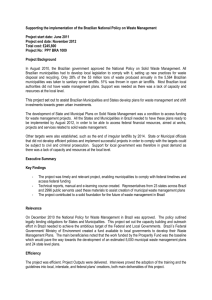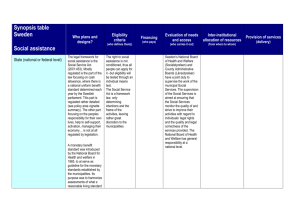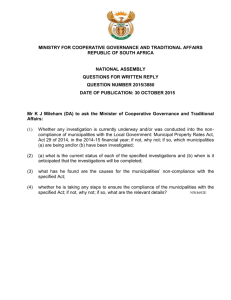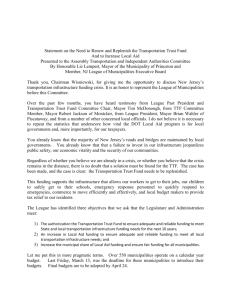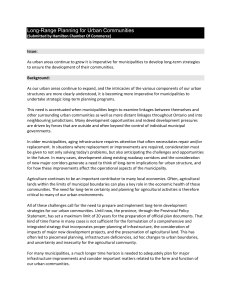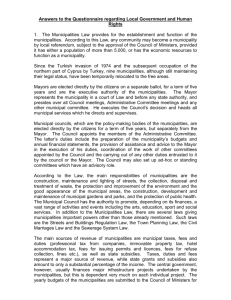Document 10465799
advertisement
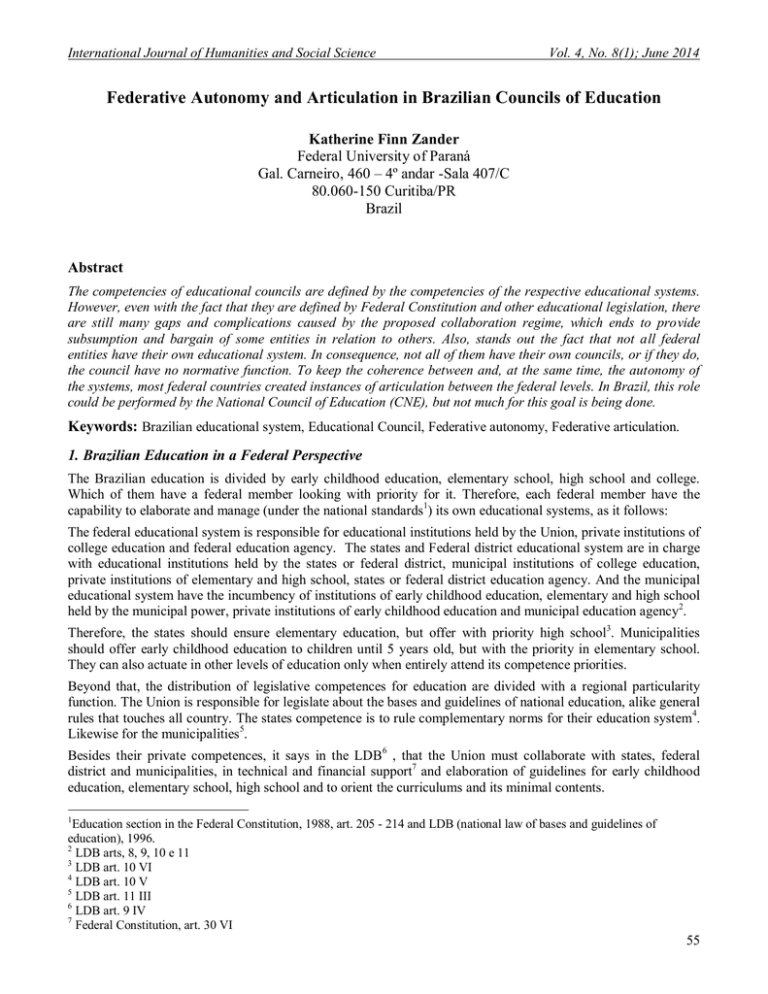
International Journal of Humanities and Social Science Vol. 4, No. 8(1); June 2014 Federative Autonomy and Articulation in Brazilian Councils of Education Katherine Finn Zander Federal University of Paraná Gal. Carneiro, 460 – 4º andar -Sala 407/C 80.060-150 Curitiba/PR Brazil Abstract The competencies of educational councils are defined by the competencies of the respective educational systems. However, even with the fact that they are defined by Federal Constitution and other educational legislation, there are still many gaps and complications caused by the proposed collaboration regime, which ends to provide subsumption and bargain of some entities in relation to others. Also, stands out the fact that not all federal entities have their own educational system. In consequence, not all of them have their own councils, or if they do, the council have no normative function. To keep the coherence between and, at the same time, the autonomy of the systems, most federal countries created instances of articulation between the federal levels. In Brazil, this role could be performed by the National Council of Education (CNE), but not much for this goal is being done. Keywords: Brazilian educational system, Educational Council, Federative autonomy, Federative articulation. 1. Brazilian Education in a Federal Perspective The Brazilian education is divided by early childhood education, elementary school, high school and college. Which of them have a federal member looking with priority for it. Therefore, each federal member have the capability to elaborate and manage (under the national standards1) its own educational systems, as it follows: The federal educational system is responsible for educational institutions held by the Union, private institutions of college education and federal education agency. The states and Federal district educational system are in charge with educational institutions held by the states or federal district, municipal institutions of college education, private institutions of elementary and high school, states or federal district education agency. And the municipal educational system have the incumbency of institutions of early childhood education, elementary and high school held by the municipal power, private institutions of early childhood education and municipal education agency2. Therefore, the states should ensure elementary education, but offer with priority high school3. Municipalities should offer early childhood education to children until 5 years old, but with the priority in elementary school. They can also actuate in other levels of education only when entirely attend its competence priorities. Beyond that, the distribution of legislative competences for education are divided with a regional particularity function. The Union is responsible for legislate about the bases and guidelines of national education, alike general rules that touches all country. The states competence is to rule complementary norms for their education system4. Likewise for the municipalities5. Besides their private competences, it says in the LDB6 , that the Union must collaborate with states, federal district and municipalities, in technical and financial support7 and elaboration of guidelines for early childhood education, elementary school, high school and to orient the curriculums and its minimal contents. 1 Education section in the Federal Constitution, 1988, art. 205 - 214 and LDB (national law of bases and guidelines of education), 1996. 2 LDB arts, 8, 9, 10 e 11 3 LDB art. 10 VI 4 LDB art. 10 V 5 LDB art. 11 III 6 LDB art. 9 IV 7 Federal Constitution, art. 30 VI 55 © Center for Promoting Ideas, USA www.ijhssnet.com For that, it is possible to notice that the LDB gives orientation to articulate the systems of education using collaboration as a principle, but in the other hand, it fails to propose instruments to materialize this principle. Thus, it is possible to assert that the Union have almost a monopoly in the process of educational rules elaboration. Maria Paula DallariBucci and Marisa AlvesVilarino (2013, p. 133), believes that this fact could be a reason for the hesitation movement that municipalities have to elaborate self-rules for their own systems. In addition, because of the municipalities’ lower ability on the management of welfare policies, comparing with the Union, which will be further analyzed in this text 8, it could be a reasonable reason to maintain the rules being ruled by the federal level. But still this is not what the constituent power meant when brought the municipalities as a federal member. Distribution of competences is distribution of power, the legislative power is considered fundamental for the existence and guarantee of federal pact. There is no federal autonomy without normative capacity above a certain area of competency. That is why the municipalities’ legitimacy to create rules should be out of doubt. 2. Councils of Education The idea of councils of education as an institution for articulation of educational systems are very common in federative countries. The first time that the Brazilian public administration thought to establish a council in education, was in 1842, with similar functions as the boards in England. But it was only in 1911 that the Higher Council of Education was established.9 This was followed by the Teaching National Council in 1925,10 and the National Council of Education (CNE) in 193111 as an consultative agency for the minister of education. It was an auxiliary agency of the executive power with technical councils. And it was its competence to elaborate an National Education Plan (PNE). In 1961 it was substituted for a Federal Education Council, given the states the opportunity to create their own education councils as well12. Moreover, in 197113was allowed the creation of the municipal education councils by the municipalities. In addition, since the Constitution of 1988, the municipalities became a federal member. That status changed the intensity of autonomy of these entities, bringing more autonomy for its agencies. Because of the huge amount of corruption denouncements, the federal council of education was extinct in 1994. And in its place was created the National Education Council in 199514. This new law vinculated the Council to the Ministry of Education, unlike what occurred with the Federal Education Council, subordinating the decisions of the collegial to the executive power (Oliveira & Sousa, 2010, p. 29, 30). Since then the CNE collaborates in the formulation of the National Policy on Education (PNE), interprets educational legislation, performs normative and deliberative functions and advises the Minister of education. More recently, watches over for education quality, to ensure the compliance of educational legislation and to shore up the society participation. In its structure, CNE has two chambers, one for basic education (early childhood, elementary and high school), other for college education and one plenary council.15 The normative power of educational councils is fixed on the limits of the competency from the federal level they are vinculated at the correspondent executive power. Therefore, the resolutions and ordinances of the CNE will related with Union competence matters, because is an agency of federal executive power. In the same way, states matters will be respective for the state Education Council, and again the same logic for the Municipal Education Council. So, to define the competences, the start point will be always the Federal Constitution and the attribution given to each federal member in the LDB. 8 See page 5, 6. Decree 8.659/1911 10 Decree 16.782-A/1925 11 Decree 19.850/1931 12 Law 4.024/1961 13 Law 5.692/1971 14 Law 9.131/1995 15 Official CNE webpage: http://goo.gl/hBD00D 9 56 International Journal of Humanities and Social Science Vol. 4, No. 8(1); June 2014 As well, some educational rules are not always explicit and sometimes they have a general description, therefore its application is made by bodies that interpret laws. This is the case of the normative character of educational council. After all, when the counselor properly interprets the law, he or she becomes a quasi-member of the legislature and their resolutions gain force of a law (Cury, 2006, p. 55). Then, the competences are not only described by law but in concrete situations. According to Cordão (2013, p. 167), itis in the constitution of doctrine about issues of competence and also following cases of experiences lived by the schools in which system, that the council will find the best ways to define the functions that the law give to them. Nevertheless, this topic is more complex than that, the competences of which council are not really established. The cooperative model makes it difficult to analyze. In reality, the simultaneous functions of CNE: normative, deliberative and consultative leads to permanent collisions with legislative, executive and judiciary power. Not to mention eventually disagreements with expectation of the educational community (Cordão, 2013, p. 167). Despite that, as an example, there is the case of the age to ingress in elementary school in the state of Paraná.16 In which the CNE gave the orientation that children who complete 6 years old during the first school year could enter to elementary school. Then, the educational council of Paraná stipulated the limit to complete 6 years old in 31th march of the first school year. Thereafter, some municipalities in Paraná, which have their own educational system with their own educational council, wrote a contradictory resolution affirming that should be no date cut for ingress in elementary school, the children should only complete 6 years old during the course of the first year. Therefore, many parents of other municipalities enter in the courts to guarantee the access to school for their children. As well some Mayors, because increasing the number of children in elementary school would be a way to receive more grants from the federal fund for fundamental education (FUNDEF), which was only given by the number of enrollments in elementary school. After more than 300 cases in the courts, the public ministry manifested bringing down the cutoff date to complete 6 years old. In addition, claimed that educational council of Paraná was not competent to decide about that matter. Thereafter came a state ordinary law ensuring that a cut date would be illegal. This mess is only illustrative to show a problem of competence and articulation involving educational councils. Thereunto, an important channel in most federations has been the establishment of formal and informal councils or committees that hold representation of different governments, ministers, officials or legislators, to share information, discuss common problems, coordinat or even joint action to establish programs. In the art. 7 of the law number 9.131/ 1995, is prescribed for the CNE the obligation to issue opinions when the matters covers more than one level or modality of education, or when concerning the implementation of educational legislation, with regard to the integration between the different levels and modalities of education. In comparative studies (Arango&Morduchowicz, 2010, p. 122, 124)it is possible to highlight the presence of instances of intergovernmental coordination in other federal countries such as a) Germany: Commission for Educational Planning and Research Promotion, and the Conference of the Ministers of Education and Cultural Affairs. b) Argentina: Federal Council of Education. c) Australia: Ministerial Council on Education: Employment, Training and Youth, and the Standing Council on School Education and Early Childhood. d)Canada: Canadian Council on Learning, and the Council of Ministers of Education. e) Spain: Sector Education Conferences. f) India: Central Advisory Board of Education. g) Mexico: National Council of Educational Authorities. h) South Africa: Council of Education Ministers. In Brazil, as the law prescribes, there is also such instance, but its functions are vinculated with the distribution of resources for the fund to maintain and develop basic education (FUNDEB)17, which is called: Intergovernmental Finance Commission for Quality in Basic Education. 16 17 Official website of a local newspaper of Curitiba - Paraná: http://goo.gl/Rdh79Y Basic education consists on: early childhood education, elementary school, high school. 57 © Center for Promoting Ideas, USA www.ijhssnet.com In that way, should the CNE be this council to articulate educational policies as a whole issue. Unfortunately, under this competence, from the year 2000, the CNE has developed not much besides the operational guidelines to the administration of early childhood education, career plan for professionals and workers of education and operation of adult education18. In other words, the CNE ends to organize an agenda for its own works that nothing have in common with federal matters. Regarding specifically the municipal councils, the Law n. 5.692/71 confirmed and expanded its normative character. In its art. 71, authorizes the municipalities, where there were conditions for such a possibility, to establish their own council of education. This fact would provide more autonomy to the municipalities, but, in the other hand, its competences may be delegated to them by their respective state council. Furthermore, about these delegated competences, the documentation analyzed (Teixeira, 2004, p. 697 - 705) shows remarkable technical and administrative connotation, making specific references to the role of this boards in planning education in the county, as well tracking and controlling the financial resources application to development and maintenance of the municipal education. Before the LDB of 1996, the CME (municipal council of education) were linked to an authorization act of CEE (state council of education), in accordance with 5.692/1971 law. That fact excluded autonomy as way of actuation. But, since the creation of the National Union of Municipal Education Managers (UNDIME) in 1986, the demand for more autonomy in municipal management of education was strongly connected to the argument of participation as a way of legitimizing the demand for enlargement of local power (Duarte & Oliveira, 2012, p. 246). Following this necessity of a broad recognition of formal political and administrative autonomy for municipalities, the national legislation about education did not required the creation of municipal councils, only authorizes its creation, unlike with the health system. Instead, in the case of education, it was required a collaborative regime as a method of balance in a possible competition between federal entities.(Duarte & Oliveira, 2012, p. 245). 3. Cooperative (or Collaborative) Regime In Brazil, it is only on educational matters that the Constitution refers cooperation as collaboration in its art. 211. and 214. It says that the Union, states, Federal District and municipalities should organized their educational systems in collaborative regime. And this is how it was arranged: “In the case of basic education, we have a Babel tower protected under the politically convenient concept of "collaborative regime". According to this concept, the three instances can run (or not) education systems; may fund (or not) education, and can choose where they want (or do not want) to act. Result: there is no instance of the government that is responsible (and accountable) for the offer (or not) of elementary school. Each instance do what it can and want, supposedly in collaborative regime” (Araujo & Oliveira, 1998). A federative model like this increases the costs of bargain for cooperation and coordination between levels of government. Is this feature that explains an important part of discoordination situations that prevail in current Brazilian federalism (Abrucio, 2013, p. 211). However, it seems that problems to articulate cooperative, or its opposite, competitive federalism are not a Brazilian characteristic. According to Watts (2006, p. 203), this is an old discussion in the doctrine: “Some of the earlier literature on federations (including judgments of the Judicial Committee of the Privy Council in a notable series of cases on Canada) spoke of federations as systems in which each government operates independently in “watertight compartments.” In practice, however, overlaps and interdependence have proved unavoidable and this raises issues of how cooperation and collaboration among them can be facilitated and excessive confrontation between them avoided.” Namely, overlaps and interdependence will arise in multi-level governance where it mixes institutions sharing rules as the same time as self-rule institutions. In that way, is unrealistic to consider that it is possible to eliminate intergovernmental competition. 18 Official CNE webpage: http://goo.gl/W0b6q9 58 International Journal of Humanities and Social Science Vol. 4, No. 8(1); June 2014 To make it more clearly, Watts (2006, p. 203, 211, 212) gives some ideas that should be considered when analyzing intergovernmental relations. First, an intense intergovernmental cooperation could undermine democratic accountability. Second, it could affect the autonomous and diverse development of policies by the constituent units taking into account that the federal government have superior financial resources, and therefore it could dominate these processes and diminish effective governance. In the Brazilian educational context, the failure feeling of collaborative regime urged the federal government to consider some alternatives to the problem. The administration of the former President Fernando Henrique Cardoso took the merit of having propelled a nationalizing action when established an evaluation criteria for distribution of resources. Moreover, the Luiz Inácio Lula da Silva government continued with this path. However, this actions does not solve the structural problem of cooperation and accountability between levels of government. Hence, the most important step to try to accomplish the multi-level collaboration regime was the creation of FUNDEF (fund of maintenance and development of fundamental school), which was replaced in 2007 for FUNDEB19 because it broadened the fund coverage spectrum for other education stages. Therefore, until the present moment, the division of competences and collaborative regime are only coming up with support in the articulation of evaluation procedures and funding. This is the regulation mode for performance (Duarte & Oliveira, 2012, p. 245), where federal and intra systemic relations are valued according to the result achieved in performance. 4. Intergovernmental Relations (IGR) and Autonomy In accordance with Allan Trench (2006, p. 231), “IGR is where constitutional politics and public policy meet. It is the point of intersection between high constitutional matters and more day-to-day concerns”. The Brazilian constitution of 1988 brought to the municipalities the status of federal entity. This fact should provide them an equal footing with the other levels of federation. Although municipalities had obtained a larger self-govern capacity in tributary, administrative and political terms, still there are some important limitations for the exercise of its power. In fact, it is not possible to consider them in the same baseline as the states and the Unit since they do not have judiciary system (Abrucio, 2013, p. 209), representation in the Senate or territory given the fact they integrate the states (Silva, 1990, p. 90, 408). Moreover, Abrucio (2013, p. 209) argues that all the autonomy gains triggered a fragmentation stimulus, and a posture less cooperative from the local governments. This becomes more troubling as the heterogeneity and inequality between municipalities are bigger than the one between the five regions of the country. It shows that the decentralization of public policies, especially the ones of welfare, to autonomous municipalities very unequal among themselves - need federal remedies to ensure the success of this process. More specifically, instruments of coordination and intergovernmental cooperation to induce improvements in municipal administrations, increase inter municipal collaboration, reduce financial disparities between municipalities and assemble federal forums for discussion and deliberation in which the municipal representatives could be heard. Thereupon, most federal systems find themselves urged to create agencies that allow the fluency of communication on sectorial policies. These agencies usual would give provisions about how to solve disputes and how to cooperate and coordinate between the members. In the case of Brazilian education, these agencies would be the educational councils. The national and the states councils are following the movements of the municipalities after the municipalization of education, preconized by the 1988 constitutional design and LDB attributions. If the municipality decides to create its own educational system, it is request from the CNE and the CEE to give support and orientations, including assistance to organize its own municipal education council (Cordão, 2013, p. 170, 171). Another option given to the municipality by the LDB is to join the state educational system. Which does not mean that the municipality should give up its duties, but only loses a partial set of autonomy. In other words, the municipality would lose its autonomy to define how things should work, however its responsibilities with early childhood education and elementary schooling will still be under its guard, maintained with its money and structure. 19 See page 9. 59 © Center for Promoting Ideas, USA www.ijhssnet.com Thus, some municipalities made their own educational system, but not all of them. In consequence, not all 5.56420 municipalities in Brazil have their own educational council. In order to illustrate, in the state of Paraná, between the 399 municipalities, only 13 have their own municipal educational system. That means that only 13 municipalities decided not to join the Parana´s educational system. In addition, in the state of Minas Gerais the incredible number of 657 between 853 municipalities have educational councils (Duarte & Oliveira, 2012, p. 246).Nevertheless, that does not mean that all of them have their own educational system. The authors above(Duarte & Oliveira, 2012, p. 252) believed that this huge number, compared with other states in Brazil, occurred because the CEE of Minas Gerais edited a resolution advising that even if the municipality join the state system it should create a municipal council with consultative function. So, most of them, those who does not have their own system, does not have normative function, because they decided to join the Minas Gerais educational system. Therefore, the allocation of regulatory powers lies on the respective state agencies. In numbers, only 54%, which means 358 municipal councils in Minas Gerais reported having normative activity. When 299 municipalities created CME without normative function. Wherefore, the creation of the municipal councils does not seems to be directly associated with the hypothesis of empowerment of the CME and the formalization of a democratic management of the education in the municipalities. The imprecision in the creation of the CMEs in Minas Gerais contributes to the uncertainties about the role of these bodies in relation to the collective management of municipal educational policies. By not establishing clear rules for the formation of CMEs, the municipal executive legally formalized its existence, but becomes empty of performance possibilities. Added to this, queried legislation(Duarte & Oliveira, 2012, p. 258) revealed contradictions between the defined competencies, the functions and nature attributed to CMEs. The absence of a federal rule that defines the nature of the councils resonated in municipalities by the development of diverse practices in managing the councils. Municipalities without associative tradition often have a formal role for its council, not minimally reaching the objectives of supervision and control of services and resources. In that way, the possibilities of acting as a more democratic instance of deliberation are reduced with the lack of clearly defined competences nationwide. But anyhow, still there is no formula to measure how much of standardization should be given in order to support a coherent national system and at the same time the opposite, how much autonomy must been given to ensure diversity into the unit. In the Brazilian federation, there is an intergovernmental relations trend, the joint of actions between the federal executive and sub national governments, contracting projects and programs by agreement on results. In other words, the new forms of intergovernmental relations find themselves merged in the old relations of centralism (Duarte & Oliveira, 2012, p. 259). The municipal councils of education, instances of social control and supervision, are responsible for monitoring actions over which they have not deliberated. The fragility on the result of educational municipalization was due to the lack of an intergovernmental model to organize the process of decentralization in education. The municipalization was linked to political negotiations between the states and municipalities, without an institutional arena for this or a clear criteria for transferring functions. There were no financial incentives, in management or for democratization to guide the relationship between levels of government and their required collaboration. Therefore, it is possible to affirm that the greatest post federal constitution difficulty was the implementation of the collaborative regime (Abrucio, 2010, p. 61). It is true that most part of the assistance to municipalities proceed from the Union, as it is common in almost all federations, however, the Brazilian states, unfortunately, have not yet taken a role coordinating with municipalities, as it happens in several federal countries, something that would generate greater intergovernmental balance. (Abrucio, 2010, p. 50). Some (Abrucio, 2013, p. 210, Bednar, 2011, p. 273) could argue that local governments also may not be more efficient. 20 Official Brazilian Senate webpage: http://goo.gl/1qHs67 60 International Journal of Humanities and Social Science Vol. 4, No. 8(1); June 2014 As O'Dwyer and Ziblatt that affirm that “in economically underdeveloped countries our study finds that decentralisation actually is associated with poorer quality of governance (…) Our concept of ‘quality of governance’ is a shorthand term for what we consider to be two important measures of how well government does its job: efficiency and effectiveness (O´Dwyer&Ziblatt, 2006, p. 327). Indeed, the federal government also has its strength linked to a greater managerial capacity derived from a more professional and meritocratic bureaucracy compared to subnational governments, particularly when one compares it with municipalities. Also in this regard, the federal government has a better preparation that has built up in decades, something that most municipalities, and even part of the less developed states, only started doing after the promulgation of the new Constitution. Therefore, the federal government keeps the concentration of most legislative competences at Union level, which has a huge power to establish normative standards for national public policies. In federal states, because of the division of power between the members, the policies initiatives are highly interdependent, but are at the same time, poorly coordinated. In that way, is needed to underline the urge to build mechanisms and institutions of negotiation and cooperation. That is why Abrucio (2013, p. 208) believes that federal forums, where federal layers could coordinate actions and negotiate conflicts, could increase better results in intergovernmental relations. An example for that is the establishment of mechanisms for intergovernmental coordination, through national regulations - as an successful case there is the National Floor Wage for Professionals of Public Education.21 5. Conclusions The educational policy has a mark on the constitution regarding federalism: a proposal for the creation of a collaborative regime, which would involve the existence of autonomous educational systems in states and municipalities and the creation of mechanisms to increase coordination and cooperation between federal entities, including a strong role of the Union. This is the challenge that, in general, has guided the changes made after the constitution of 1988. Thus, the evolution of federal cooperation in Brazil depends on a process of interaction and collaboration in a long-term period to be achieved in permanent instances of cooperation. This tendency is verified in fields such as health and environment. However, in the case of educational councils it is predominant the verticalization and tutelage, overlaps and omission of one level above another, that leads to more dependency instead of autonomy, mainly in the municipalities case. The political capacity, financial and administrative management of the Union acts upon the inequality of conditions present in Brazilian federalism. Therefore, the federal government has an important power as an inequalities corrector, although this sometimes means more political weight in bargaining with other levels of government, creating a higher but not desirable dependence of the states and local governments over the federal executive. But, as it was saw, for political federal systems some degree of interdependence is common. However, would be beneficial to consolidate strong tools to prevent the total decharacterization of autonomy principles. Otherwise, what should be collaboration between systems became subordination. In the educational field it is missed an instance of federal cooperation, committed with educational development in a national level, composed by representants of each unit of the federation with tangible and determined attributions. An articulation instance, with negotiation power, executive nature, with the representation of states and municipalities education secretaries. This agency could fill the emptiness of coordination that compromise the evolution of educational politics. Still there are some good examples of federal articulation in education, which were pointed along the text22 as the National Floor Wage for Professionals of Public Education, FUNDEF and FUNDEB. Nevertheless, they are not enough. The educational councils have an reduced articulation role. The National Education Council could be, alternatively, this federative articulation venue. 21 22 Law 11.738/2008. FUNDEB p. 3, FUNDEF p. 5, national floor wage p. 7. 61 © Center for Promoting Ideas, USA www.ijhssnet.com Enshrining what was discussed at the National Conference on Education (CONAE) of 2010 about the construction of a national articulated system of education.23 6. References Abrucio, F. L. (2010). A dinâmica federativa da educação brasileira: diagnóstico e propostas de aperfeiçoamento.Educação e Federalismo no Brasil: combater as desigualdades, garantir a diversidade.Oliveira e Santana (Eds.). Brasília: UNESCO. Abrucio, F. L. (2013). Federalismo e educação no Brasil: trajetória recente e principais desafios. Justiça pela qualidade na educação/ ABMP, Todos pela educação (Eds). - São Paulo: Saraiva. Arango A. e Morduchowicz. (2010). Desenho institucional e articulação do federalismo educativo: experiências internacionais.Educação e Federalismo no Brasil: combater as desigualdades, garantir a diversidade.Oliveira e Santana (Eds.). Brasília: UNESCO. Araújo e Oliveira, J.B. (1998). Avanços e impasses na educação: à guisa de balanço. Revista do Legislativo, Belo Horizonte. Bednar, Jenna. (2011).The Political Science of Federalism.Annual Review of Law and Social Science 7, n. 1 (pp. 269-­‐288). Bucci M. P. D. &Vilarino M. A. (2013).A ordenação federativa da educação brasileira e seu impacto sobre a formação e o controle das políticas públicas educacionais.Justiça pela qualidade na educação/ ABMP, Todos pela educação (Eds). - São Paulo: Saraiva. Brazil/MEC/CNE.[Online] Available:http://goo.gl/W0b6q9 (October 14, 2013). Brazil/MEC/CNE. [Online]Available:http://goo.gl/hBD00D(October 14, 2013). Brazil/MEC/CONAE.[Online] Available:http://goo.gl/wQ7jcK(October 15, 2013). O'Dwyer, C. &Ziblatt, D. (2006), Does Decentralisation Make Government More Efficient and Effective?Commonwealth and Comparative Politics. 44, n. 3 (pp. 326-­‐343). Cordão, F. A. (2013).Regulação e controle das políticas públicas educacionais.Justiça pela qualidade na educação/ ABMP. Todos pela educação (Eds). - São Paulo: Saraiva. Cury, C. R. J. (2006).Conselhos de Educação: fundamentos e funções. RBPAE – v.22, n.1, (pp. 41-67). Czelusnia, A. (2013). Confusão sobre idade para entrar no ensino fundamental completa 6 anos.[Online] Available:http://goo.gl/Rdh79Y(October 12, 2013). Duarte, M. R. T. and Oliveira, R. de F. (2012).Sistemas municipais de ensino em Minas Gerais: o papel dos conselhos municipais de educação.Educação em Revista, Belo Horizonte, v. 28 n. 04 (pp. 243-262). Oliveira R. P. de, & Sousa S. Z. Introdução. (2010).Educação e Federalismo no Brasil: combater as desigualdades, garantir a diversidade.Oliveira e Santana (Eds.). Brasília: UNESCO. Silva, J. A. (1990). Curso de Direito Constitucional Positivo. Revista dos Tribunais. São Paulo, (pp. 90 e 408). Teixeira, L. H. G. (2004). Conselhos Municipais de educação: Autonomia e democratização do ensino. Cadernos de Pesquisa, v. 34, n. 123, (pp. 691-708). Trench, A. (2006). Intergovernmental Relations: In Search of a Theory. Territory, Democracy and Justice: Regionalism and Federalism in Western Democracies. Edited by Scott L Greer. Basingstoke: Palgrave Macmillan. Watts, R. L. (2006). Origins of Cooperative and Competitive Federalism.Territory, Democracy and Justice: Regionalism and Federalism in Western Democracies. Edited by Scott L Greer. Basingstoke: Palgrave Macmillan. 7. Normative References Brazil, Federal Constitution, 1988. Brazil, Law nº 4.024, of 20th december, 1961. Brazil, Law nº 5692, of 11th august, 1971. Brazil, Law nº 9.131 of 24th november,1995. Brazil, Law n° 9.394 of 20th December, 1996 - (LDB). Brazil, Law nº 11.738, of 16th july, 2008. Brazil, Decree nº 8.659, of 05th april, 1911. Brazil, Decree nº 16.782-A, of 13th january, 1925. Brazil, Decree nº 19.850, de 11th april, 1931. 23 Official website of the Ministry of Education: http://goo.gl/wQ7jcK 62
